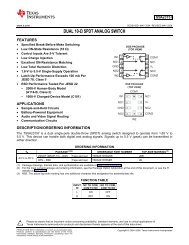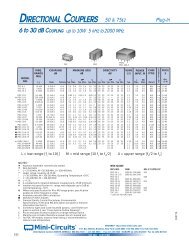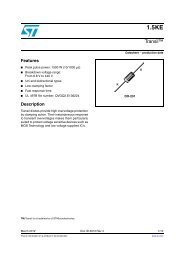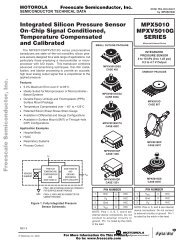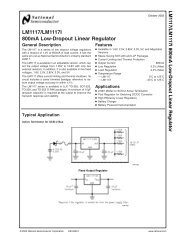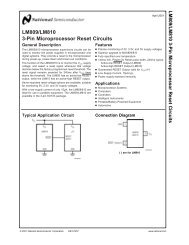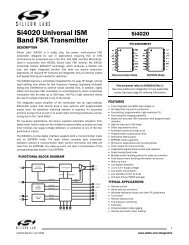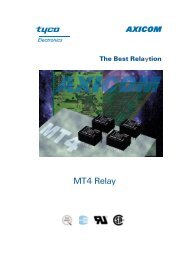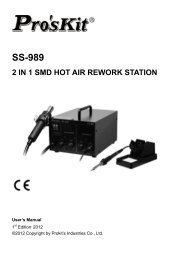LM3445 Triac Dimmable Offline LED Driver
LM3445 Triac Dimmable Offline LED Driver
LM3445 Triac Dimmable Offline LED Driver
You also want an ePaper? Increase the reach of your titles
YUMPU automatically turns print PDFs into web optimized ePapers that Google loves.
<strong>LM3445</strong><br />
Determining the capacitance value of the valley-fill capacitors:<br />
The valley fill capacitors should be sized to supply energy to<br />
the buck converter (V BUCK ) when the input line is less than its<br />
peak divided by the number of stages used in the valley fill<br />
(t X ). The capacitance value should be calculated when the<br />
triac is not firing, i.e. when full <strong>LED</strong> current is being drawn by<br />
the <strong>LED</strong> string. The maximum power is delivered to the <strong>LED</strong><br />
string at this time, and therefore the most capacitance will be<br />
needed.<br />
operate at much lower and higher input voltages a range<br />
is needed to illustrate the design process.<br />
2. How many stages are implemented in the valley-fill circuit<br />
(1, 2 or 3).<br />
In this example the most common valley-fill circuit will be used<br />
(two stages).<br />
30060354<br />
FIGURE 20. AC Line with Firing Angles<br />
30060352<br />
FIGURE 19. Two Stage Valley-Ffill V BUCK Voltage with no<br />
TRIAC Dimming<br />
Figure 21 show three triac dimmed waveforms. One can easily<br />
see that the peak voltage (V PEAK ) from 0° to 90° will always<br />
be:<br />
From the above illustration and the equation for current in a<br />
capacitor, i = C x dV/dt, the amount of capacitance needed at<br />
V BUCK will be calculated as follows:<br />
At 60Hz, and a valley-fill circuit of two stages, the hold up time<br />
(t X ) required at V BUCK is calculated as follows. The total angle<br />
of an AC half cycle is 180° and the total time of a half AC line<br />
cycle is 8.33 ms. When the angle of the AC waveform is at<br />
30° and 150°, the voltage of the AC line is exactly ½ of its<br />
peak. With a two stage valley-fill circuit, this is the point where<br />
the <strong>LED</strong> string switches from power being derived from AC<br />
line to power being derived from the hold up capacitors (C7<br />
and C9). 60° out of 180° of the cycle or 1/3 of the cycle the<br />
power is derived from the hold up capacitors (1/3 x 8.33 ms<br />
= 2.78 ms). This is equal to the hold up time (dt) from the<br />
above equation, and dv is the amount of voltage the circuit is<br />
allowed to droop. From the next section (“Determining Maximum<br />
Number of Series Connected <strong>LED</strong>s Allowed”) we know<br />
the minimum V BUCK voltage will be about 45V for a 90V AC to<br />
135V AC line. At 90V AC low line operating condition input, ½ of<br />
the peak voltage is 64V. Therefore with some margin the voltage<br />
at V BUCK can not droop more than about 15V (dv). (i) is<br />
equal to (P OUT /V BUCK ), where P OUT is equal to (V <strong>LED</strong> x I <strong>LED</strong> ).<br />
Total capacitance (C7 in parallel with C9) can now be calculated.<br />
See “ Design Example" section for further calculations<br />
of the valley-fill capacitors.<br />
Determining Maximum Number of Series Connected<br />
<strong>LED</strong>s Allowed:<br />
The <strong>LM3445</strong> is an off-line buck topology <strong>LED</strong> driver. A buck<br />
converter topology requires that the input voltage (V BUCK ) of<br />
the output circuit must be greater than the voltage of the <strong>LED</strong><br />
stack (V <strong>LED</strong> ) for proper regulation. One must determine what<br />
the minimum voltage observed by the buck converter will be<br />
before the maximum number of <strong>LED</strong>s allowed can be determined.<br />
Two variables will have to be determined in order to<br />
accomplish this.<br />
1. AC line operating voltage. This is usually 90V AC to<br />
135V AC for North America. Although the <strong>LM3445</strong> can<br />
Once the triac is firing at an angle greater than 90° the peak<br />
voltage will lower and equal to:<br />
The voltage at V BUCK with a valley fill stage of two will look<br />
similar to the waveforms of figure 22.<br />
The purpose of the valley fill circuit is to allow the buck converter<br />
to pull power directly off of the AC line when the line<br />
voltage is greater than its peak voltage divided by two (two<br />
stage valley fill circuit). During this time, the capacitors within<br />
the valley fill circuit (C7 and C8) are charged up to the peak<br />
of the AC line voltage. Once the line drops below its peak<br />
divided by two, the two capacitors are placed in parallel and<br />
deliver power to the buck converter. One can now see that if<br />
the peak of the AC line voltage is lowered due to variations in<br />
the line voltage, or if the triac is firing at an angle above 90°,<br />
the DC offset (V DC ) will lower. V DC is the lowest value that<br />
voltage V BUCK will encounter.<br />
Example:<br />
Line voltage = 90V AC to 135V AC<br />
Valley-Fill = two stage<br />
Depending on what type and value of capacitors are used,<br />
some derating should be used for voltage droop when the<br />
www.national.com 20



